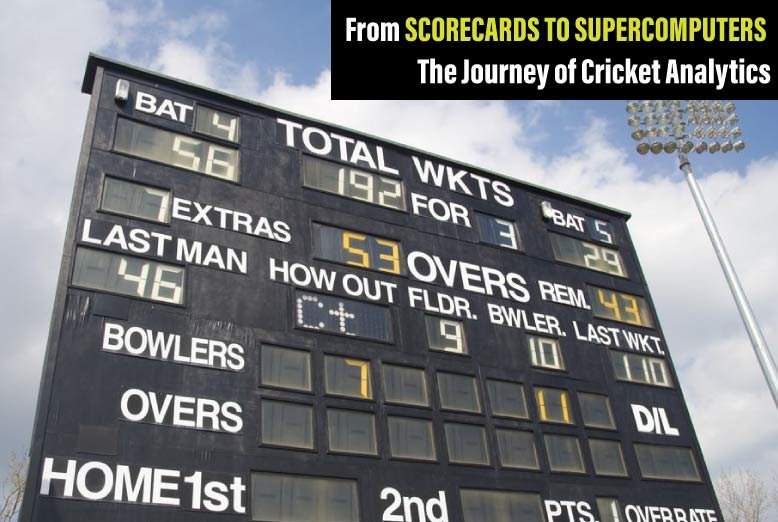Cricket has been enjoyed worldwide for hundreds of years. Almost as long as the sport has existed, people have recorded statistics of players and games. In the past, these were used simply for record-keeping purposes that could be referred to from time to time.
But with analytics becoming a part of everyday life in the modern world, these records are now the key to accurate and historical data points for analytic models. Although this requires a degree of work, particularly in capturing all historical data still kept on a paper scorecard, the benefits of this work are undeniable.
Early Statistics
The earliest cricket scorecards can be traced back to 1697. The statistics gleaned from these are incredibly inconsistent, and it appears that only some games were considered worthy enough to have their scorecards recorded.
By 1894, however, things began to change. With the formalization of first-class cricket at the Marylebone Cricket Club, it was agreed that all games—at least those played within Great Britain—should be recorded.
These recordings were done on paper and filed, providing decent insight into cricket during the era. However, compared to more modern stats used in cricket analytics, these fall far below the current standard and sometimes included only basic details like which team won.
In May 1947, first-class cricket was formally defined by the Imperial Cricket Conference (which became the International Cricket Council in 1987). As part of the definition, an agreement was made to officially begin recording statistics during games, and the ICC has kept a record of all cricket statistics ever since.
Digital Statistics
There is no agreed-upon date on which cricket statistics made the move to computers. But with the rapid rise of computer technology, particularly toward the end of the 20th century, it was around this era that scorecards were replaced with databases.
Since then, things have evolved quickly, and the results of practically every cricket match nowadays are captured digitally in explicit detail. This includes the players who competed, how many runs each player achieved, how many balls were bowled, and how players were sent out.
One of the most significant improvements to the digital capturing of these statistics was the implementation of DRS (Decision Review Systems). Hawk-Eye, one of the most advanced versions of these systems, acts as a third umpire and uses a collection of video cameras to capture footage of every aspect of the game.
Should an occurrence appear where the umpire is not entirely confident in calling a decision or if his decision is queried, DRS is employed. Although DRS has been in place since 1992, Hawk-Eye was first used during a 2015 match between Australia and New Zealand. The tech allows an additional umpire to review slow-motion footage with multiple metrics to confirm or dispute a decision.
Systems like this, which are run by multiple computers and algorithms and featured in many of the largest cricket stadiums, have greatly enhanced the accuracy of recorded statistics. This, in turn, has led to significantly more accurate historical data in all forms of cricket.
Benefits of Statistics
The benefits of recording all cricket statistics in computer databases are almost incalculable. However, this information is not available only to coaches and players; cricket fans can access the latest T20 team rankings and many other useful stats via popular sites like ESPN Cricinfo.
This information can be used to create data points for analytic algorithms or manual calculations of analytical trends. These trends and analytics have multiple uses for anybody who loves the game, including the following:
Strategy Planning
With the availability of these analytics, teams can study how their opponents have played historically and the styles they employed during different matches. This allows the teams to adapt their own play style and approach to an upcoming match in a way that will give them the best chance at success.
One of the best examples of this is the English cricket team. Following an embarrassing show during the 2015 ICC Cricket World Cup, the team spent four years reviewing analytical information on play styles and honing how they approached competitions. This paid off during the next Cricket World Cup in 2019, when they beat New Zealand in the final and took home the trophy.
Team Selection
Aside from helping determine how a team should approach their play style, player statistics can also assist coaches in deciding which players to place in a team for upcoming matches. This is done by using player statistics head-to-head in an algorithm to determine which players are best suited to go against players on the opposing team.
With this information, teams can be put together with specific players that will have the best chance of beating the opposing team members.
Win Probability
Another massive area where these statistics and analytics are commonly used is in the growing sports betting industry. Fans who enjoy cricket betting in India and other countries where the sport is widespread use these statistics as data points in win probability algorithms.
These algorithms, which have become significantly more advanced in recent years, use these data points to build probability calculators. Based on data such as which players will be competing in an upcoming match, where the game will be played, and weather and pitch conditions, these algorithms can help determine the winning team. Gamblers use this information to place more accurate bets.
Conclusion
Cricket analytics have come a long way from the basic records kept in the 17th century on which team won. With advanced technological systems such as DRS and the help of multiple algorithms to aid in predictions, statistics gathered during matches are worth their weight in gold and can drastically help teams and fans betting on them.
With the continued implementation of AI in these algorithms, cricket predictions, models, and team advisories are becoming increasingly more accurate. This leads to a new level of understanding of the game and is helping to make the sport more enjoyable.
ALSO READ: 10 Largest cricket stadiums in the world that will Awestruck every Cricket Fan

















